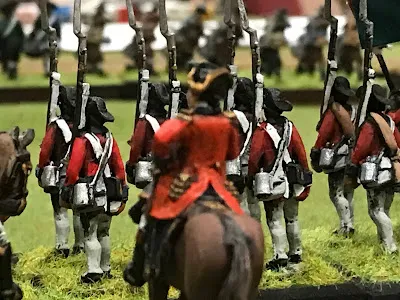One of the more unusual and colorful units of the American army were its rifle armed regiments. Dressed in colorful uniforms these units were armed with the more accurate rifle. Because they saw service through the war they add a colorful and unusual element to your army.
Uniforms for these troops were anything but uniform. Usually dressed in the hunting shirt and trousers, a round hat and leather accutraments. These differed from men to man and a wide range of freedom is granted to the wargamer in painting these figures. Shirts were usually brown or tan but could also be green, black, or blue. Sometimes the fringe of the shirt was dyed a different color. This makes it easy to create a pool of figures that can be brought together for any campaign or battle.
Some historical regiments included the following regiments:
Campbell's (Richard) Virginia Rifle battalion: numbered about 200 men and fought at Guilford Courthouse. A smaller number later saw service at Hobkirk Hill and Eutaw Springs.
Campbell's (William) Virginia Rifle battalion: Fought at King's Mountain and another group later saw service in the Virginia campaign under Lafayette.
Parr's Pennsylvania Rifle battalion: Raised in July 1781 and served during the Yorktown campaign. This same officer appeared to have commanded the Pennsylvania Rifle men during Sullivan's 1779 campaign.
Lynch's Virginia Rifle battalion: fought at Guilford Courthouse and a smaller group later served with Greene until the end of 1781.
Pennsylvania State regiment: The Pennsylvania Battalion of Rifles and the Pennsylvania Battalion of Musketry, were raised in February 1776. They were organized into two battalions of riflemen commanded by Colonel Samuel Atlee and one battalion of musket men commanded by Colonel Samuel Miles.
Sent to New York city to join the main American army under General Washington they arrived On 11August and were assigned to the brigade commanded by Brigadier Lord Stirling. During the Battle of Long Island (27August 1776) both battalions were decimated. Colonels Atlee and Miles were captured and the three battalions were consolidated into a single battalion under Colonel Daniel Brodhead and now revered to as the Pennsylvania State Battalion. As such they continued to campaigned with Washington's army.
The Rifle battalion had blue faced white coats, white waistcoat edged red. They wore black caps marked "PR" or hats. Lead/ black orbrown/tan colored hunting shirts are also mentioned. My guess (opinion only ) could have been officers in uniform and riflemen in hunting shirts. But this is only a guess on my part. The musketeers battalion had blue regimental coats faced red, white waistcoat and buckskin breeches, hats bound yellow. returns from the State Battalion suggested blue regimental coats faced red with white small clothes. In addition a flag was supposed to have been issued to the rifle battalions. "2 standards with a rifle man on" is how it is described. Possibly (my guess) it and could have been similar to the flag of the Hanover Associated with a red field and rifle man in green hunting shirt. The is also a mention of Colonel Magaw's purple standard being captured at Fort Washington.
Morgan's Rifle battalion: two different units were associated with Daniel Morgan. In 1775 Morgan commanded a company from Virginia that marched six hundred miles to the siege of Boston. He later commanded the rifle companies during the march to Quebec city and the assault on that city. Although the attack was a failure Morgan's reputation was enhanced by his sterling service. Although captured he was later exchanged.
Following his exchange he was prompted to command of the 11th Virginia regiment. He was later instructed by General Washington to form a new Corps of five hundred men called the Provincial Rifle Corps. They first saw service against the British under General William Howe during the operations around New Jersey. They we're then moved to the northern theater and played a decisive role in the Saratoga campaign.
Thompson's Pennsylvania Rifles: Organized in June 1775 the regiment served during b the siege if Boston and later in the New York and New Jersey campaigns. In 1777 the regiment was reorganized as a line regiment.
Maryland and Virginia Rifles: Also known as Rawling's Rifle Regiment consisted of nine companies from Maryland and five companies from Virginia. Because of the mixed nature of the unit it was considered a extra Continental line reginent. The regiment was captured at Fort Washington in November 1776. The surviving elements continued to serve with Washington at Trenton and Princeton.
Rifled armed regiments should have special abilities in your game. They have a much longer range then muskets and they should have a higher possible chance to score a hit. This makes them excellent skirmish troops who could be used to harass and snipe at the line troops. But, they were not supermen and they also had their disadvantages. Although more accurate then the smooth bore musket rifles took longer to load and could not mount a bayonet which gives them a disadvantage in close combat. Because of this reason Morgan at Saratoga had a battalion of light infantry that operated with his rifles. He later wrote "My rifle men would have been of little service if they had not always had a line of musket and bayonet men to support us."
.jpeg)

.jpeg)


.jpeg)

.jpeg)
.jpeg)
.jpeg)

















